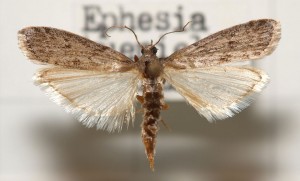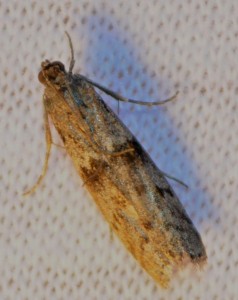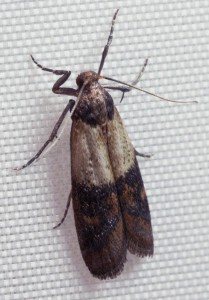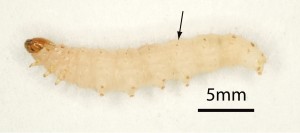Facts about the Mediterranean Flour Moth
Occurrence: The mediterranean flour moth(Ephestia kuehniella) is not particularly common in US homes. It is most often found in bakeries and other places where large quantities of flour and grain products are present. If you find moths in food items in your kitchen, it is more likely to be the indian meal moth. The Mediterranean flour moth was first reported in North America in 1889.
Diet: Mediterranean flour moths are food moths that prefer to lay their eggs in flour, so their larvae can feed on it. The larvae are the real pests, as they are the ones that eat the flour and contaminate it with their feces and webs. Additionally, the larvae can survive on other dry food products such as grains, cereals, and breakfast foods.
Control: Controlling mediterranean flour moths involves removing all eggs, larvae, and adult moths. When they appear in private homes, there is often a limited number of larvae in a bag of flour or grains. In such cases, you should discard the food, empty the cupboard where the food was stored, and vacuum it thoroughly.
Steps for Control
-
Inspection: Eggs and larvae are found in dry food products in the kitchen, particularly flour. Inspect all such food items thoroughly. If there are signs of moths, discard the food and remove the waste from your home immediately.
-
Cleaning: Clean all kitchen cabinets where dry food items are stored. Never use water for cleaning, as moisture enhances the conditions for mediterranean flour moths and other moth species. Instead, use a vacuum cleaner and a dry cloth dampened with regular vinegar to do the following:
- Vacuum all kitchen cabinets and surrounding areas thoroughly, paying special attention to corners, cracks, crevices, holes, etc.
- Wipe all surfaces, corners, edges, and rims with the vinegar cloth.
Origin: Mediterranean flour moths in homes often originate from grain storage facilities, mills, bakeries, or similar places. Moths are brought into homes through food products that were previously in contact with a mediterranean flour moth population.
Persistent problems: In case of severe or recurring infestations, inspect different parts of the kitchen to determine if the mediterranean flour moths are developing in your home. Begin with the kitchen cabinets where the infested food was stored. If possible, move or remove the cabinet. Do the same with other kitchen elements (such as appliances, exhaust hoods, etc.) where moths may have hidden their eggs and larvae. If eggs and larvae are found, clean them using the method described above (vacuuming and wiping). We also recommend using mediterranean flour moth traps for both prevention and control.
Prevention
To avoid future infestations, do the following:
- Store all dry food items in tightly sealed containers.
- Regularly clean kitchen cabinets thoroughly without using water.
- Keep cabinets organized and frequently sort through food items.
- Discard any food items past their expiration date.
- Purchase smaller quantities of dried food at a time.
- Use mediterranean flour moth traps.
Proper food storage is a crucial part of preventing moth infestations. By limiting the moths' access to food, you significantly reduce their ability to reproduce. Keep in mind that mediterranean flour moths often come from a store or another point in the food distribution or production chain, and it is important to address the problem at its source.
Mediterranean flour moth or Indian meal moth?
The mediterranean flour moth is similar in many ways to the indian meal moth, as they both develop in similar environments, live in the same places, and cause similar damage. However, in private homes, Indian meal moths are much more common than mediterranean flour moths. The easiest way to distinguish between the two species is by looking at their adult forms.
Signs of Infestation
When you discover mediterranean flour moths in flour or other dry food items, there are usually a few larvae along with their excrement and webs. Food items such as flour, grains, and seeds become clumped together, foul-smelling, and discolored (often gray-brown) due to the larvae's webs and excrement.
In dried fruits (such as figs, apricots, etc.), the larvae typically hide in the fruit's natural folds and wrinkles or where the fruits touch each other. The fruits often have holes where the larvae have burrowed. This also applies to nuts.
Discarding Food
If the damage to the food is minimal, you can freeze it at -18°C for at least two days or heat it to 60°C for at least one hour. Alternatively, you can simply discard the food. Remember to immediately throw out the garbage bag in an outdoor trash container.
Description of the Mediterranean Flour Moth
Adult mediterranean flour moths: Adults are 1.0 – 1.4 cm long with a wingspan of 1.6 – 2.7 cm. They have long, light gray or brown-gray forewings with dark patterns (often “bands” or zigzag patterns) or spots. However, the wing patterns may be blurred or faint. The hind wings are white-gray. The head and body are gray. mediterranean flour moths tend to stay in the shadows and prefer the warmest areas they can find. In practice, they often sit on ceilings.
Larvae: The larvae have white-yellowish or slightly pinkish bodies with black spots, which they use to spin their cocoons. Their heads are reddish-brown. The larvae are very small at hatching and grow up to 12 mm as fully grown larvae. When a larva begins to spin its cocoon, its body takes on a more reddish-brown hue.
Eggs: Mediterranean flour moth eggs are oval, with a small white-gray protrusion at one end. The eggs are tiny (0.57 x 0.30 mm) and barely visible to the naked eye.
Mediterranean flour moth caterpillars have black spots on their bodies that are used to spin their pupae
Mediterranean Flour Moth Life Cycle
Adult moths: Female moths can mate only once, while males can mate 5 – 6 times during their lifespan. The lifespan of adult mediterranean flour moths varies greatly, and they can live around 20 days if they don’t find a mate, and even longer at lower temperatures (10 – 18°C), provided they have access to enough food and moisture. While adults can consume moisture from fruit juices and the like, they generally do not feed.
Eggs: Female moths are stimulated by flour and other dust materials such as pollen and talcum powder. Females can gather piles of these materials in cracks, crevices, holes, etc. (for example, in a kitchen cabinet) and lay their eggs in them. Females lay 116 – 678 eggs in their lifetime (an average of 200), with 75% laid within 48 hours of stimulation. The final offspring number ranges between 50 and 500, depending on the parents' health conditions at mating and the light conditions the males are exposed to. Larvae can only develop at temperatures between 8°C and 32°C (at higher or lower temperatures, development stops entirely). Eggs hatch after 4 – 14 days. Read more about moth eggs here.
Larvae: The larvae feed on the food source they hatch on, often flour but also other grains and even nuts, dried fruits, mushrooms, peat, rotting wood, and more. Larvae are light-averse and usually remain hidden in the food where they hatched. When fully grown, they move to the food's surface and toward a crack, crevice, hole, or corner to pupate. Read more about moth larvae here.
Pupa: Once the larva finds a suitable location, it spins its cocoon and remains there until it becomes an adult. The pupal stage usually lasts 17 – 20 days but can last several months in colder temperatures. If temperatures become low enough, the pupated larvae enter a state of dormancy. When the pupal stage ends, the adult moth emerges from its cocoon and mates shortly thereafter.
The total lifecycle of a mediterranean flour moth can range from 30 days to about 300 days, depending on temperature and food availability. You can read more about the moth life cycle here.




